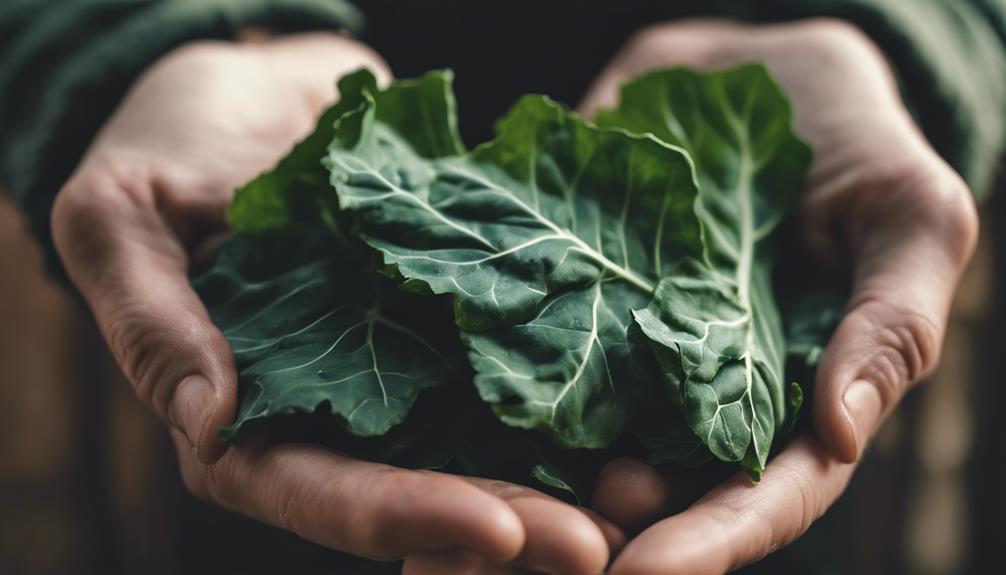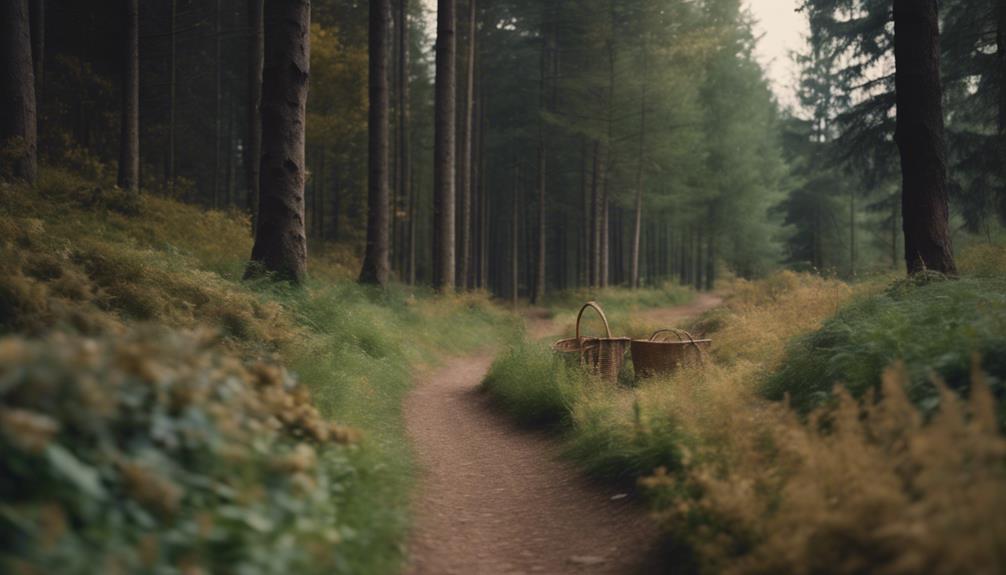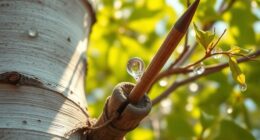You can eat Impact Forage Collards, a type of collard green that's not only safe for human consumption but also packed with nutrients, vitamins, and antioxidants, making it a great addition to a healthy diet. With their slightly bitter taste and tough, leathery leaves, they're a cool-season crop that thrives in cooler temperatures. Rich in vitamins A and C, calcium, and fiber, collard greens support heart health, digestion, and overall well-being. Whether you forage for them in the wild or grow your own, you can enjoy collards through various cooking methods, from steaming to sautéing. Explore their culinary possibilities and discover more about this nutritious superfood.
Key Takeaways
- Impact Forage Collards are edible and packed with vitamins, minerals, and antioxidants, making them a nutritious addition to meals.
- The leaves are slightly bitter-tasting and can be harvested and prepared in various ways, including steaming, sautéing, and boiling.
- To ensure safe consumption, choose harvesting locations away from pollution sources, inspect plants for damage, and wash harvested collard greens thoroughly.
- Impact Forage Collards support overall health and well-being by boosting the immune system, improving digestion, and providing anti-inflammatory properties.
- With their versatility and ease of growth, Impact Forage Collards can be a sustainable and rewarding addition to home gardens and meals.
Identifying Impact Forage Collards
When identifying Impact Forage Collards, you'll typically notice their distinctive, dark green, slightly bitter-tasting leaves, which can grow up to 3 feet tall and 2 feet wide. These leaves are tough and leathery, making them palatable to livestock and wildlife.
As you examine the plant, you'll see that it's a cool-season crop, which means it thrives in cooler temperatures. Impact Forage Collards are also versatile and can be planted in various conditions and seasons, making them a great addition to your garden or farm.
When it's time to harvest, you'll want to identify the leaves that are at their peak flavor and nutritional value. Simply snip off the leaves you want to use, making sure to leave enough for the plant to continue growing. You can harvest individual leaves or take the entire head, depending on your needs.
With proper identification and harvesting, you'll be able to enjoy the benefits of Impact Forage Collards in your cooking and as a nutritious addition to your meals.
Nutritional Benefits of Collard Greens

As you explore the benefits of Impact Forage Collards, you'll discover that they're a nutritional powerhouse, packed with vitamins, minerals, and antioxidants that can elevate your overall health and well-being.
These supergreens are rich in essential vitamins like A and C, as well as calcium, making them a great addition to your diet.
With only a few calories but a wealth of fiber, Impact Forage Collards can support healthy digestion and satiety.
As an added bonus, they're packed with antioxidants, which help shield your cells from damage and reduce inflammation in the body.
By incorporating Impact Forage Collards into your meals, you can potentially reap benefits like improved heart health, reduced chronic disease risk, and enhanced overall well-being.
Whether you're planning a Collard Planting project or simply looking to spice up your meals, these nutritious greens are definitely worth considering.
Harvesting Wild Collard Greens Safely

How do you guarantee that the wild collard greens you harvest are safe to eat, free from harmful contaminants and pollutants?
When harvesting wild collard greens, it's crucial to take necessary precautions to ensure their safety for consumption.
Here are three key tips to keep in mind:
- Choose the right location: Avoid harvesting near areas with high levels of pollution, such as roadsides or industrial areas. Opt for areas with minimal human activity and pollution.
- Inspect before picking: Inspect the plants for signs of damage, rot, or pests. Avoid picking plants with visible signs of decay or infestation.
- Wash thoroughly: Wash the harvested collard greens thoroughly with clean water to remove any dirt, debris, or potential pollutants.
Preparing Collards for Consumption

Now that you've harvested your Impact Forage Collards, it's time to get them ready for the plate.
You'll need to wash and clean the leaves to remove any dirt or debris, and then decide how to handle the stems – whether to remove them entirely or chop them up finely.
Washing and Cleaning
When preparing Impact Forage Collards for consumption, you'll want to start by washing and cleaning them thoroughly to remove any dirt or residue. This vital step ensures food safety and hygiene standards are met.
As you wash your collards under running water, gently rub the leaves to remove any dirt or debris that may be hiding in the crevices.
Here are some key tips to keep in mind while washing and cleaning your Impact Forage Collards:
- Remove any damaged or wilted leaves to improve the overall quality of the collards.
- Inspect the leaves carefully to catch any dirt or residue that may have been missed.
- Pat the leaves dry with a clean towel or paper towels to remove excess moisture.
Stem Removal Methods
You'll need to eliminate the tough stems from your Impact Forage Collards to guarantee their full flavor and texture potential. This essential step guarantees that your collards are tender and enjoyable to eat.
When planting Impact Forage Collards, you mightn't think about the stems, but when it's time to consume them, those stems become a hindrance. Removing the stems is a simple process that makes a huge difference in the overall eating experience.
To do so, fold the leaf in half lengthwise and cut along the stem to separate it. This method allows you to easily remove the tough, fibrous stem, leaving you with the tender and flavorful leaf.
By removing the stems, you'll be left with a delicious and nutritious leaf that's perfect for adding to salads, sautéing, or cooking in your favorite dishes.
Cooking Methods for Delicious Collards

By utilizing a few simple cooking techniques into your routine, you can reveal the rich, earthy flavor and tender texture that makes Impact Forage Collards a culinary delight.
To get started, try these three cooking methods to bring out the best in your collards:
- Steaming: Steaming Impact Forage Collards helps bring out their nutrients and delicate flavor. Simply chop the leaves, place them in a steamer basket, and steam for 5-7 minutes until tender.
- Sautéing: Sautéing adds a crispy texture and savory flavor to your collards. Heat some olive oil in a pan, add chopped onions and garlic, and then add the collard leaves. Cook until wilted, about 5 minutes.
- Boiling: Boiling is a simple way to cook Impact Forage Collards. Bring a pot of salted water to a boil, add the chopped leaves, and cook until tender, about 10-15 minutes. Drain and season with your favorite spices.
Remember to experiment with different seasonings and cooking techniques to find your favorite way to prepare Impact Forage Collards. With a little creativity, you can reveal the full flavor and nutrition of these delicious greens.
Foraging for Collards in the Wild

When considering foraging for wild collards, it's important to first learn how to correctly identify the plant to avoid mistakenly picking toxic look-alikes. You don't want to end up with a handful of poisonous plants, so take the time to educate yourself.
Consider taking foraging classes or consulting with an expert to make certain you know what you're doing. Wild collards can be found growing in fields, meadows, and along roadsides, but it's vital to identify them correctly. Look for the characteristic heart-shaped leaves with wavy edges and a slightly bitter taste.
Be cautious of areas that may have been sprayed with chemicals or pesticides, as these can be harmful to your health. Once you've identified and harvested your wild collards, make sure to wash them thoroughly and cook them properly to prevent any potential health risks.
With the right knowledge and precautions, foraging for wild collards can be a fun and rewarding experience, providing you with a nutritious and delicious addition to your meals.
Growing Your Own Collard Greens

Now that you've mastered the art of foraging for wild collards, consider taking the next step and growing your own Impact Forage Collards, a nutrient-dense and versatile leafy green perfect for culinary use. By growing your own, you'll have a steady supply of fresh, healthy greens right in your backyard.
Plus, Impact Forage Collards are easy to grow and can thrive in a variety of conditions, making them a great choice for gardeners in NE Wisconsin.
Here are a few benefits to growing your own Impact Forage Collards:
- Freshness: Harvest your collards at the peak of freshness, ensuring maximum flavor and nutrition.
- Convenience: Have a constant supply of fresh collards right in your backyard, saving you trips to the store.
- Customization: Grow your collards to your liking, experimenting with different cooking methods and recipes.
With Impact Forage Collards, you'll enjoy a nutrient-rich addition to your meals, packed with vitamins and minerals. By growing your own, you'll have the freedom to experiment with different recipes and cooking methods, taking your culinary skills to the next level.
Frequently Asked Questions
Are Forage Collards Edible for Humans?
You're wondering if forage collards are edible for humans, and the answer is yes! You can eat them, and they're packed with nutrients, making them a healthy addition to your meals, whether cooked or raw. In fact, forage collards for human consumption are similar to traditional collard greens and can be prepared in much the same way — sautéed, steamed, or added to soups and stews. They have a robust flavor and are an excellent source of vitamins A, C, and K, as well as fiber. Additionally, their hardy leaves stand up well to cooking, making them a versatile and nutritious option for a variety of dishes. If you’re still asking, *are forage collards safe to eat*, rest assured they are perfectly safe for human consumption when properly washed and prepared. Like traditional collards, forage collards can be enjoyed in salads when young and tender, or cooked down to soften their texture and enhance their flavor. Their versatility and nutrient density make them an excellent addition to a balanced diet.
Can You Eat Collards After They Bolt?
You can eat collards after they bolt, but you'll find they're bitter and tough, unlike the tender leaves you're used to; still, some people enjoy them, while others replant for a fresher harvest.
What Is Forage Collards?
You're wondering what forage collards are! They're a type of cool-season cover crop, known for producing massive biomass for soil health and livestock grazing, while being nutrient-dense, versatile, and beneficial for the environment.
Can You Eat the Seed Pods From Collard Greens?
You can definitely eat the seed pods from collard greens, and they're a tasty, nutritious addition to meals, offering a slightly bitter, nutty flavor and a boost of vitamins, minerals, and fiber.
Conclusion
You've discovered the secrets of impact forage collards, and now you're ready to reap the rewards. Like a master chef seasoning a dish, you've added the perfect blend of knowledge to your culinary repertoire.
With the right techniques and precautions, you can savor the nutty flavor and bask in the nutritional benefits of these superfood greens.
So go ahead, get foraging, and indulge in the harvest – your taste buds and body will thank you!










